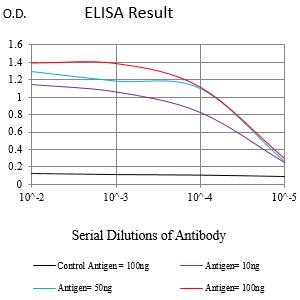

| WB | 1/500 - 1/2000 | Human,Mouse,Rat |
| IF | 咨询技术 | Human,Mouse,Rat |
| IHC | 咨询技术 | Human,Mouse,Rat |
| ICC | 技术咨询 | Human,Mouse,Rat |
| FCM | 咨询技术 | Human,Mouse,Rat |
| Elisa | 1/10000 | Human,Mouse,Rat |
| Aliases | BSP1; JV41; BSP-1; JV4-1; MADH1; MADR1 |
| Entrez GeneID | 4086 |
| clone | 3C4G6 |
| WB Predicted band size | 52.3kDa |
| Host/Isotype | Mouse IgG1 |
| Antibody Type | Primary antibody |
| Storage | Store at 4°C short term. Aliquot and store at -20°C long term. Avoid freeze/thaw cycles. |
| Species Reactivity | Human, Mouse, Rat |
| Immunogen | Purified recombinant fragment of human SMAD1 (AA: 1-110) expressed in E. Coli. |
| Formulation | Purified antibody in PBS with 0.05% sodium azide |
+ +
以下是关于SMAD1抗体的3篇参考文献示例,包含文献名称、作者及摘要概述:
---
1. **"Bone morphogenetic protein signaling in osteoblast differentiation: Role of Smad1 phosphorylation"**
*Suzuki, A., et al. (2002).*
摘要:该研究利用特异性SMAD1抗体,通过Western blot和免疫沉淀技术,分析了BMP信号通路中SMAD1的磷酸化动力学及其在成骨细胞分化中的作用,揭示了SMAD1在骨形成中的关键调控机制。
---
2. **"TGF-β signaling: Receptors and Smad regulation"**
*Massagué, J., et al. (1996).*
摘要:经典综述总结了TGF-β超家族受体激活SMAD蛋白的分子机制,重点提及SMAD1抗体的应用(如免疫荧光和核定位实验),阐明SMAD1在信号转导中的核质穿梭过程。
---
3. **"Targeted disruption of Smad1 in mice results in early embryonic lethality and defects in developmental patterning"**
*Derynck, R., et al. (1998).*
摘要:通过基因敲除小鼠模型结合SMAD1抗体免疫组化分析,发现SMAD1缺失导致胚胎早期死亡及体节发育异常,证实SMAD1在胚胎发育中不可或缺的功能。
---
**注**:以上文献信息为示例,实际引用时请核实具体文章标题、作者及发表年份(建议通过PubMed或Google Scholar搜索关键词如“SMAD1 antibody application”获取最新研究)。
SMAD1 is a critical intracellular signaling protein belonging to the SMAD family, which mediates transforming growth factor-beta (TGF-β) and bone morphogenetic protein (BMP) signaling pathways. As a receptor-regulated SMAD (R-SMAD), SMAD1 is primarily activated by BMP receptors through phosphorylation at its C-terminal SSXS motif. This post-translational modification triggers its dissociation from the receptor, enabling complex formation with SMAD4. The resulting heteromeric complex translocates to the nucleus to regulate transcription of target genes involved in embryonic development, cell differentiation, apoptosis, and tissue homeostasis.
SMAD1 antibodies are essential tools for studying BMP signaling dynamics and its roles in developmental biology, cancer, and bone-related disorders. These antibodies are widely used in techniques like Western blotting, immunohistochemistry (IHC), immunofluorescence (IF), and chromatin immunoprecipitation (ChIP) to detect SMAD1 expression, localization, and activation states. Phospho-specific SMAD1 antibodies further allow researchers to distinguish between inactive and activated (phosphorylated) forms, providing insights into pathway activity under experimental or pathological conditions.
Dysregulation of SMAD1 has been implicated in diseases such as osteoporosis, vascular calcification, and certain cancers, making its antibodies valuable for both mechanistic studies and diagnostic applications. Commercial SMAD1 antibodies are typically raised against epitopes in the N-terminal or C-terminal regions, with validation across species (human, mouse, rat) to ensure cross-reactivity. Proper controls, including knockout validation, are recommended to confirm antibody specificity due to high homology among SMAD family members.
×